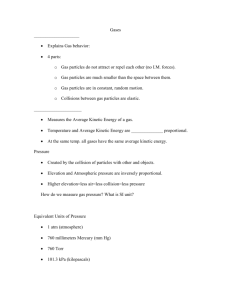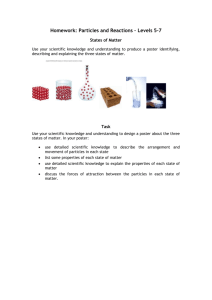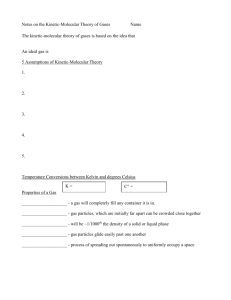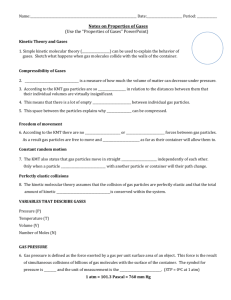Chapter 12 Gases 12.1 Characteristics of gases A. Properties of
advertisement
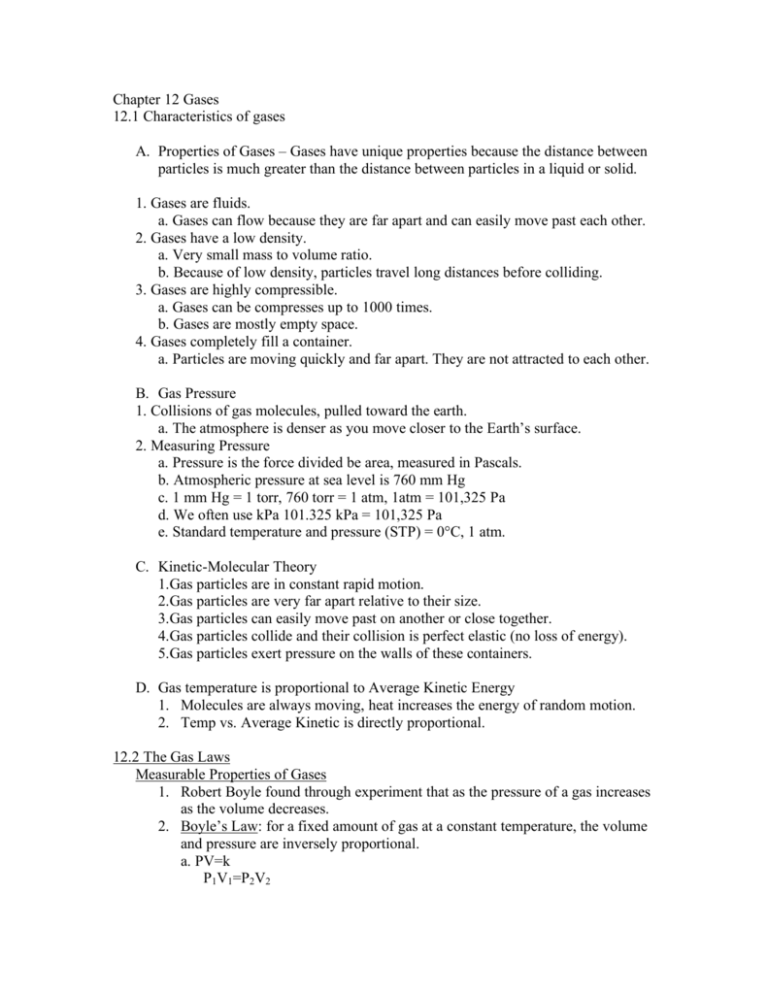
Chapter 12 Gases 12.1 Characteristics of gases A. Properties of Gases – Gases have unique properties because the distance between particles is much greater than the distance between particles in a liquid or solid. 1. Gases are fluids. a. Gases can flow because they are far apart and can easily move past each other. 2. Gases have a low density. a. Very small mass to volume ratio. b. Because of low density, particles travel long distances before colliding. 3. Gases are highly compressible. a. Gases can be compresses up to 1000 times. b. Gases are mostly empty space. 4. Gases completely fill a container. a. Particles are moving quickly and far apart. They are not attracted to each other. B. Gas Pressure 1. Collisions of gas molecules, pulled toward the earth. a. The atmosphere is denser as you move closer to the Earth’s surface. 2. Measuring Pressure a. Pressure is the force divided be area, measured in Pascals. b. Atmospheric pressure at sea level is 760 mm Hg c. 1 mm Hg = 1 torr, 760 torr = 1 atm, 1atm = 101,325 Pa d. We often use kPa 101.325 kPa = 101,325 Pa e. Standard temperature and pressure (STP) = 0°C, 1 atm. C. Kinetic-Molecular Theory 1.Gas particles are in constant rapid motion. 2.Gas particles are very far apart relative to their size. 3.Gas particles can easily move past on another or close together. 4.Gas particles collide and their collision is perfect elastic (no loss of energy). 5.Gas particles exert pressure on the walls of these containers. D. Gas temperature is proportional to Average Kinetic Energy 1. Molecules are always moving, heat increases the energy of random motion. 2. Temp vs. Average Kinetic is directly proportional. 12.2 The Gas Laws Measurable Properties of Gases 1. Robert Boyle found through experiment that as the pressure of a gas increases as the volume decreases. 2. Boyle’s Law: for a fixed amount of gas at a constant temperature, the volume and pressure are inversely proportional. a. PV=k P1V1=P2V2 3. Jacques Charles discovered that volume is directly proportional to temperature on the Kelvin scale. The pressure must remain constant. 4. Charles’s Law: for a fixed amount of gas at a constant pressure, the volume and temperature are directly proportional. a. V/T = k V1/T1 = V2/T2 5. Joseph Gay-Lussac discovered that as the temperature increases, the pressure increases. 6. Gay-Lussac’s Law: The pressure of a gas at a constant volume is directly proportional to temperature. a) The addition of energy causes the collisions to increase. b) k = P/T P1/T1 = P2/T2 7. Amadeo Avogadro proposed that equal volumes of all gases, under the same conditions have the same number of particles, a) k = V/n V1/n1 = V2/n2 b) 22.4 L = 1 mol gas at STP 8. Combined gas formula P1V1/T1 = P2V2/T2 12.3 Molecular Composition of Gases A. Ideal Gas Law 1. Ideal Gas: an imaginary gas whose particles are infinitely small and do not interact with each other. a. Does not condense to liquid at low temperature, does not have forces of attraction between particles, no volume. 2. All gas laws can be combined into one equation. Pv = nRT, PV = mRT/M, D = PM/RT a. R = gas constant = 8.314 L•kP / mol•K or 0.08206 L•atm/K•mol 3. Not ideal at high pressure on low temperatures B. Gas behavior and Chemical Formulas 1.Diffusion - the movement of particles from regions of higher density to regions of lower density. (high conc. low conc.) a. Diffusion involves increased randomness (entropy). 2. Effusion - the passage of a gas under pressure through a tiny opening. a. Grahm's law of effusion - the rate of diffusion of a gas is inversely proportional to the square root of the gas's molar mass. rate of effusion for gas 1 = (m2/m1)1/2 rate of effusion for gas 2 VH2 = (MO2/MH2) 1/2 VO2 3. Dalton's Law of Portal Pressure - the total pressure of a mixture of gases is equal to the sum of the partial pressures of each gas. Ptot = P1 + P2 + P3 ….. C. Gas Stoichiometry 1. Gas problems can be solved using PV=nRT
